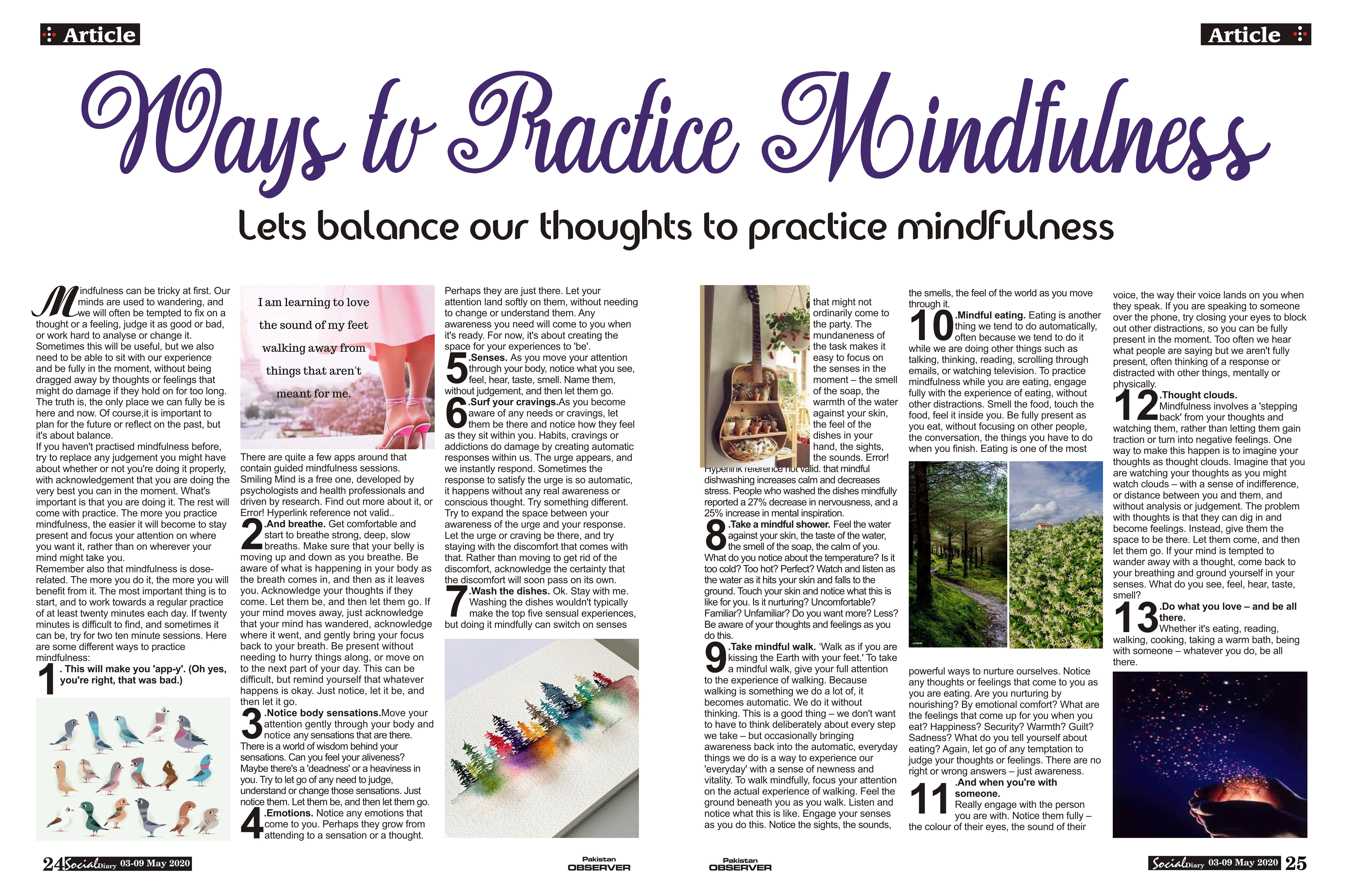Lets balance our thoughts to practice mindfulness
Mindfulness can be tricky at first. Our minds are used to wandering, and we will often be tempted to fix on a thought or a feeling, judge it as good or bad, or work hard to analyse or change it. Sometimes this will be useful, but we also need to be able to sit with our experience and be fully in the moment, without being dragged away by thoughts or feelings that might do damage if they hold on for too long. The truth is, the only place we can fully be is here and now. Of course,it is important to plan for the future or reflect on the past, but it’s about balance.
If you haven’t practised mindfulness before, try to replace any judgement you might have about whether or not you’re doing it properly, with acknowledgement that you are doing the very best you can in the moment. What’s important is that you are doing it. The rest will come with practice. The more you practice mindfulness, the easier it will become to stay present and focus your attention on where you want it, rather than on wherever your mind might take you.
Remember also that mindfulness is dose-related. The more you do it, the more you will benefit from it. The most important thing is to start, and to work towards a regular practice of at least twenty minutes each day. If twenty minutes is difficult to find, and sometimes it can be, try for two ten minute sessions. Here are some different ways to practice mindfulness:

- This will make you ‘app-y’. (Oh yes, you’re right, that was bad.)
There are quite a few apps around that contain guided mindfulness sessions. Smiling Mind is a free one, developed by psychologists and health professionals and driven by research. Find out more about it, or Error! Hyperlink reference not valid..
2.And breathe. Get comfortable and start to breathe strong, deep, slow breaths. Make sure that your belly is moving up and down as you breathe. Be aware of what is happening in your body as the breath comes in, and then as it leaves you. Acknowledge your thoughts if they come. Let them be, and then let them go. If your mind moves away, just acknowledge that your mind has wandered, acknowledge where it went, and gently bring your focus back to your breath. Be present without needing to hurry things along, or move on to the next part of your day. This can be difficult, but remind yourself that whatever happens is okay. Just notice, let it be, and then let it go.
3.Notice body sensations. Move your attention gently through your body and notice any sensations that are there. There is a world of wisdom behind your sensations. Can you feel your aliveness? Maybe there’s a ‘deadness’ or a heaviness in you. Try to let go of any need to judge, understand or change those sensations. Just notice them. Let them be, and then let them go.
4.Emotions. Notice any emotions that come to you. Perhaps they grow from attending to a sensation or a thought. Perhaps they are just there. Let your attention land softly on them, without needing to change or understand them. Any awareness you need will come to you when it’s ready. For now, it’s about creating the space for your experiences to ‘be’.
5.Senses. As you move your attention through your body, notice what you see, feel, hear, taste, smell. Name them, without judgement, and then let them go.
6.Surf your cravings. As you become aware of any needs or cravings, let them be there and notice how they feel as they sit within you. Habits, cravings or addictions do damage by creating automatic responses within us. The urge appears, and we instantly respond. Sometimes the response to satisfy the urge is so automatic, it happens without any real awareness or conscious thought. Try something different. Try to expand the space between your awareness of the urge and your response. Let the urge or craving be there, and try staying with the discomfort that comes with that. Rather than moving to get rid of the discomfort, acknowledge the certainty that the discomfort will soon pass on its own.
7.Wash the dishes. Ok. Stay with me. Washing the dishes wouldn’t typically make the top five sensual experiences, but doing it mindfully can switch on senses that might not ordinarily come to the party. The mundaneness of the task makes it easy to focus on the senses in the moment – the smell of the soap, the warmth of the water against your skin, the feel of the dishes in your hand, the sights, the sounds. Error! Hyperlink reference not valid. that mindful dishwashing increases calm and decreases stress. People who washed the dishes mindfully reported a 27% decrease in nervousness, and a 25% increase in mental inspiration.
8.Take a mindful shower. Feel the water against your skin, the taste of the water, the smell of the soap, the calm of you. What do you notice about the temperature? Is it too cold? Too hot? Perfect? Watch and listen as the water as it hits your skin and falls to the ground. Touch your skin and notice what this is like for you. Is it nurturing? Uncomfortable? Familiar? Unfamiliar? Do you want more? Less? Be aware of your thoughts and feelings as you do this.
9.Take mindful walk. ‘Walk as if you are kissing the Earth with your feet.’ To take a mindful walk, give your full attention to the experience of walking. Because walking is something we do a lot of, it becomes automatic. We do it without thinking. This is a good thing – we don’t want to have to think deliberately about every step we take – but occasionally bringing awareness back into the automatic, everyday things we do is a way to experience our ‘everyday’ with a sense of newness and vitality. To walk mindfully, focus your attention on the actual experience of walking. Feel the ground beneath you as you walk. Listen and notice what this is like. Engage your senses as you do this. Notice the sights, the sounds, the smells, the feel of the world as you move through it.
10.Mindful eating. Eating is another thing we tend to do automatically, often because we tend to do it while we are doing other things such as talking, thinking, reading, scrolling through emails, or watching television. To practice mindfulness while you are eating, engage fully with the experience of eating, without other distractions. Smell the food, touch the food, feel it inside you. Be fully present as you eat, without focusing on other people, the conversation, the things you have to do when you finish. Eating is one of the most powerful ways to nurture ourselves. Notice any thoughts or feelings that come to you as you are eating. Are you nurturing by nourishing? By emotional comfort? What are the feelings that come up for you when you eat? Happiness? Security? Warmth? Guilt? Sadness? What do you tell yourself about eating? Again, let go of any temptation to judge your thoughts or feelings. There are no right or wrong answers – just awareness.
11.And when you’re with someone.
Really engage with the person you are with. Notice them fully – the colour of their eyes, the sound of their voice, the way their voice lands on you when they speak. If you are speaking to someone over the phone, try closing your eyes to block out other distractions, so you can be fully present in the moment. Too often we hear what people are saying but we aren’t fully present, often thinking of a response or distracted with other things, mentally or physically.
12.Thought clouds.
Mindfulness involves a ‘stepping back’ from your thoughts and watching them, rather than letting them gain traction or turn into negative feelings. One way to make this happen is to imagine your thoughts as thought clouds. Imagine that you are watching your thoughts as you might watch clouds – with a sense of indifference, or distance between you and them, and without analysis or judgement. The problem with thoughts is that they can dig in and become feelings. Instead, give them the space to be there. Let them come, and then let them go. If your mind is tempted to wander away with a thought, come back to your breathing and ground yourself in your senses. What do you see, feel, hear, taste, smell?
13.Do what you love – and be all there.
Whether it’s eating, reading, walking, cooking, taking a warm bath, being with someone – whatever you do, be all there.

























